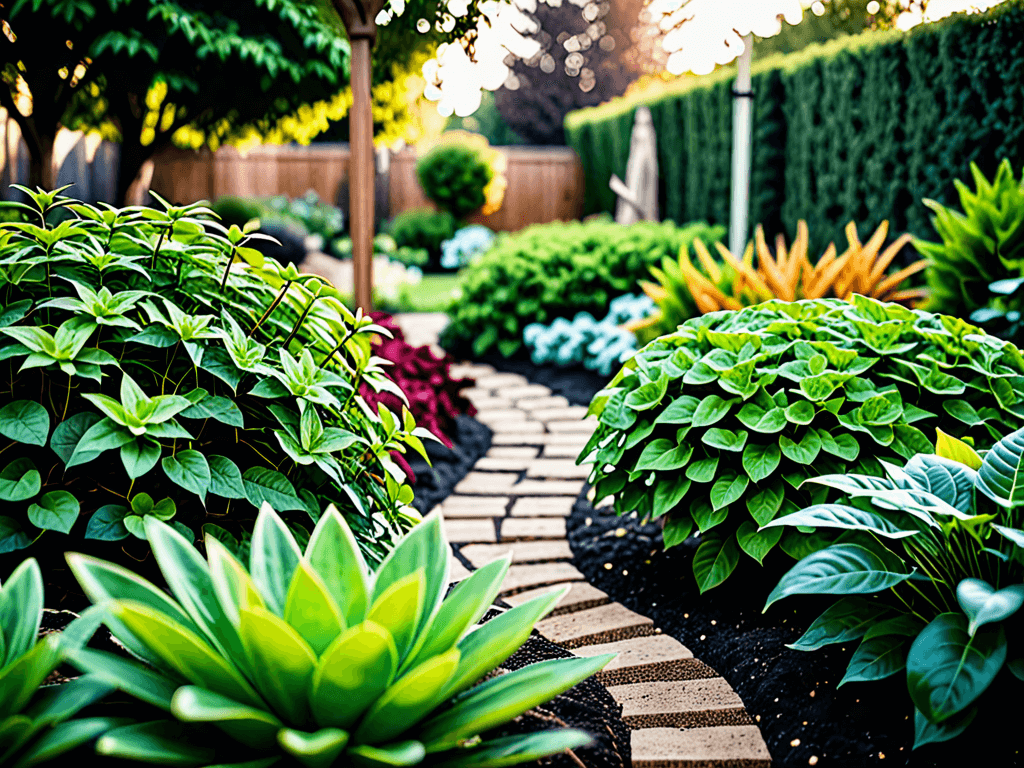Sustainable Gardening Tips are essential for anyone looking to make their gardening practices more eco-friendly.
Aiming for an environmentally conscious approach not only benefits nature but can also offer more rewarding gardening experiences.
In this guide, discover tips to enhance your garden’s sustainability while considering elements like water conservation, chemical reduction, and biodiversity support, all aligned with the outlined principles.
Understanding Sustainable Gardening Principles
Sustainable gardening focuses on practices that preserve resources, promote biodiversity, and maintain the health of your garden ecosystem.
By understanding these principles, gardeners can create spaces that thrive naturally and require fewer artificial inputs.
One core principle is soil health; maintaining rich, organic soil helps plants grow robustly with fewer fertilizers.
Another is choosing native plants suited to local climates, which often require less water and are more resilient to pests.
Sustainable gardening also encourages habitats for beneficial insects and animals, promoting a balanced ecosystem.
Mulching is a simple practice that retains moisture and reduces weeds, supporting both plant health and water conservation.
Selecting Eco-Friendly Plants
Choosing eco-friendly plants is crucial for a sustainable garden. Native plants are ideal as they are adapted to the local environment and require less water and care.
Pollinator-friendly plants like wildflowers can support bees and butterflies, enhancing biodiversity in your garden.
Consider drought-resistant varieties for areas prone to dry spells, which can conserve water and reduce the need for irrigation.
Incorporating a mix of herbaceous and woody plants can provide shelter and food for wildlife.
Select plants known for natural pest resistance to minimize chemical use, supporting a healthier garden ecosystem.
Implementing Water-Saving Techniques
Water conservation is a key aspect of sustainable gardening. Installing a rainwater collection system allows you to use natural rainfall to water your plants, conserving tap water.
Drip irrigation systems can efficiently water plant roots directly, reducing evaporation and runoff.
Mulching around plants not only retains moisture in the soil but also suppresses weeds that compete for water.
Consider grouping plants with similar water needs together to optimize watering.
Employing greywater systems to recycle household water for the garden is another effective method.
Choose plants that thrive on less water, further supporting your eco-friendly gardening efforts.
Minimizing Chemical Use
Reducing chemical use in your garden supports not only environmental health but also personal safety.
Begin by choosing plants naturally resistant to pests and diseases, minimizing the need for pesticides.
Implement crop rotation techniques to disrupt the cycle of disease and pest habitats.
Using organic fertilizers, such as compost or well-rotted manure, supplies nutrients without harmful chemicals.
Encourage beneficial insects like ladybugs and lacewings that naturally control pest populations.
Handpicking larger pests can also reduce the need for chemical interventions.
Integrating natural repellents, like garlic or chili sprays, provides a safer pest control method compared to synthetics.
Creating a Wildlife-Friendly Garden
Creating a wildlife-friendly garden enhances your outdoor space’s ecological value.
Start by incorporating a variety of native plants that provide food and habitat for local wildlife.
Consider adding a water source, like a birdbath or small pond, to attract birds and other creatures.
Install birdhouses and bat boxes to offer shelter.
Using hedges or dense shrubs creates safe spaces for small animals.
Avoid chemicals that can harm wildlife, opting instead for natural pest control methods.
Pile logs or rocks to make hiding spots for beneficial reptiles and amphibians.
Your garden will become a thriving haven for biodiversity.
Practicing Composting and Recycling
Composting and recycling are vital practices for a sustainable garden. Composting helps turn organic waste like food scraps and garden trimmings into rich soil amendments, reducing the need for chemical fertilizers.
Start a compost pile or bin in a shaded area, mixing greens like fruit peels with browns such as dried leaves. Turn the pile regularly to speed up decomposition.
Recycling involves reusing garden materials when possible; old pots can become planters and wooden pallets can be transformed into plant beds.
By practicing these methods, you contribute to waste reduction and promote a balanced ecosystem in your garden.
Maximizing Resource Efficiency
Maximizing resource efficiency in your garden involves minimal waste and optimal use of materials.
Plan your garden layout to maximize sunlight exposure, reducing the need for artificial lighting.
Collect rainwater in barrels for watering plants and use solar-powered lights to illuminate paths and patios.
Repurpose household items like jars for seed starting, and focus on perennial plants which provide yields over multiple seasons, reducing the need for annual replanting.
Employ crop rotation techniques to keep soil nutrients balanced and preserve the health of your garden.
Planning for Seasonal Changes
Planning for seasonal changes ensures your garden remains productive and vibrant year-round.
Begin by researching which plants thrive in each season and strategically arrange them in your garden.
Implement cover crops in the winter to protect soil, prevent erosion, and maintain fertility.
Consider using cold frames or greenhouses to extend your growing season and protect sensitive plants.
Rotating crops according to their seasonal preferences helps prevent soil depletion and disease.
Use mulches to insulate plants against temperature extremes and conserve moisture.
As conditions change, adjust your watering and fertilization strategies to meet the specific needs of each season.
Conclusion: Embracing Sustainable Gardening
Practicing sustainable gardening offers numerous benefits for both individuals and the environment, from conserving resources to fostering biodiversity.
By implementing eco-friendly practices like selecting native plants, minimizing chemical use, and optimizing resource efficiency, gardeners can create thriving, self-sustaining landscapes.
Understanding seasonal changes and supporting local wildlife further enhances the garden’s ecological impact, making it a haven for nature.
Ultimately, these efforts contribute to a healthier planet, demonstrating that small, mindful actions in our gardens can lead to significant positive changes in the wider ecosystem.
Frequently Asked Questions about Sustainable Gardening
What is sustainable gardening?
Sustainable gardening involves creating an eco-friendly garden that conserves resources and supports biodiversity through practices like composting and avoiding chemicals.
How can I conserve water while gardening?
Use drip irrigation, collect rainwater, and plant drought-resistant varieties to minimize water use.
What plants are best for a sustainable garden?
Native and pollinator-friendly plants are ideal as they require less care and naturally support local ecosystems.
Why is minimizing chemical use important in gardening?
Reducing chemicals protects both the environment and human health, encouraging a natural balance in the garden.
How does composting benefit my garden?
Composting turns organic waste into nutrient-rich soil amendments, reducing waste and improving plant health.
How can I attract wildlife to my garden?
Plant native species, provide water sources, and create habitats like birdhouses to invite wildlife.
How do I plan my garden for seasonal changes?
Choose plants suited to each season, utilize covers like greenhouses, and adjust care routines accordingly.


